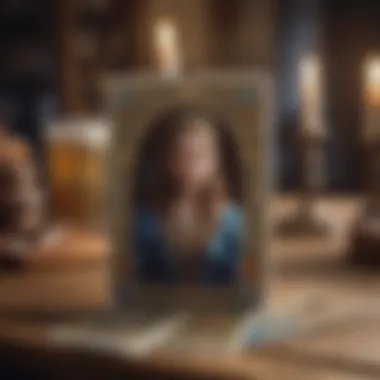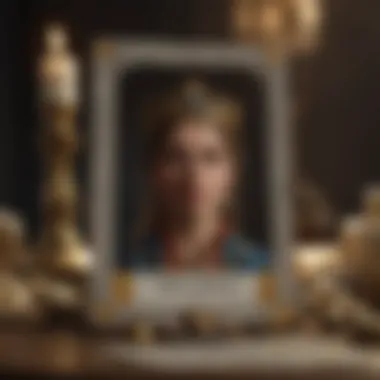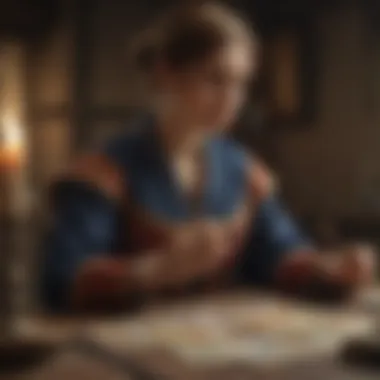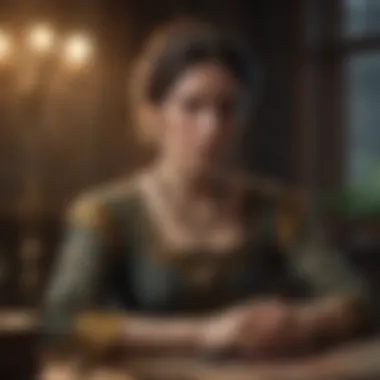Exploring the Rider-Waite Tarot: A Comprehensive Guide


Intro
The Rider-Waite Tarot deck is a significant structure in the realm of divination. Its influence extends beyond mere card reading; it has shaped the practice of tarot itself. Originating in the early 20th century, this deck marks a pivotal moment in tarot history. With its vivid imagery and rich symbolism, it invites practitioners to explore their inner selves and the universe around them.
This guide is designed for those who wish to deepen their comprehension of the Rider-Waite Tarot. By examining its historical context, symbolic elements, and practical applications, readers will discover how this deck operates not only as a tool for readings but also as an object of art and insight.
Understanding the layers of meaning embedded within each card enhances one's ability to give and receive readings. Thus, we will uncover the relationships between the cards, their meanings, and how they can help facilitate personal growth or insight into various aspects of life.
In the following sections, we will explore the imagery and interpretations of both the Major and Minor Arcana, practical reading techniques, and a consideration of the philosophical principles grounding tarot practice.
Preamble to the Rider-Waite Tarot
The Rider-Waite Tarot deck holds a pivotal place in the world of tarot. The importance of this deck in both historical and contemporary contexts cannot be overstated. With its rich symbolism and profound imagery, it serves as a foundational tool for many practitioners of divination and self-reflection. This introduction provides an overview of the Rider-Waite Tarot's significance, setting the stage for a deeper exploration of its components.
One cannot appreciate the Rider-Waite Tarot without understanding its origins and the key figures involved in creating it. This deck is more than just a collection of cards; it embodies the fusion of artistic expression and esoteric knowledge. Its appeal lies in its accessibility and the depth of insight it offers, making it suitable for both beginners and seasoned tarologists.
In this article, we will discuss several key elements of the Rider-Waite Tarot:
- The historical background of the deck and its creators.
- The structure of the tarot deck, including the Major and Minor Arcana.
- The symbolism that plays a crucial role in interpreting the cards.
- Practical application of the deck for readings.
Understanding these facets will not only enhance the reader's grasp of tarot but also illuminate the broader implications of its use in personal and collective contexts.
Origins of the Rider-Waite Deck
The origins of the Rider-Waite Tarot deck date back to early 20th century London. The deck was created by Arthur Edward Waite, a member of the Hermetic Order of the Golden Dawn, and illustrated by Pamela Colman Smith. Those two are significant for the development of tarot as we know it today. The deck was first published in 1909 and quickly gained popularity, largely due to its unique imagery, which deviated from earlier tarot designs.
Waite's vision was to bring tarot to a wider audience. He aimed to create a deck that was not only visually appealing but also rich in meaning. Pamela Smith's illustrations expressed complex ideas and made the cards more relatable. Thus, the Rider-Waite deck became a bridge between the esoteric traditions and the common person seeking guidance.
Key Figures: Waite and Smith
Arthur Edward Waite and Pamela Colman Smith represent the duality of intellect and artistry in the creation of the Rider-Waite Tarot. Waite's background in mysticism and occult practices contributed to the philosophical depth of the cards. He meticulously selected symbols that would resonate with the spiritual journeys of individuals.
On the other hand, Smith brought those symbols to life with her artistic talent. Her use of color and imagery made each card visually impactful. They encapsulated the essence of the messages contained within. This collaboration resulted in a tarot deck that is both profound and accessible.
Their combined efforts not only revolutionized tarot design but also established a significant precedent for future decks. Each card in the Rider-Waite Tarot tells a story, allowing the reader to engage with the narrative of their own lives. Consequently, the influence of Waite and Smith continues to be felt in contemporary tarot practices, evidencing the enduring legacy of their work.
The Structure of the Tarot Deck
Understanding the structure of the Tarot deck is crucial for navigating the intricate world of tarot readings. The Rider-Waite Tarot specifically consists of 78 cards, divided into two main parts: the Major Arcana and the Minor Arcana. Each section serves its unique purpose, contributing to the depth and complexity of the readings.
The structure allows users to interpret various aspects of life. The Major Arcana reflects significant life themes and spiritual lessons. In contrast, the Minor Arcana addresses day-to-day experiences and challenges. This division helps readers to contextualize the messages received during a reading, offering nuanced insights into personal growth and immediate concerns. Readers must grasp this structure to enhance their interpretative skills and provide accurate insights to the querent.
Major Arcana Explained
The Major Arcana comprises 22 cards, numbered from 0 (The Fool) to 21 (The World). These cards embody the journey of the soul, capturing profound themes such as intuition, change, and self-discovery. Each card holds distinct meanings, influenced by its imagery and symbolism.
For example, The Fool symbolizes beginnings and spontaneity. It suggests taking risks and embracing the unknown. Conversely, The Tower signifies upheaval and revelation, serving as a reminder of the need for transformation. The Major Arcana cards can overshadow the Minor Arcana due to their intensity. Still, their presence in a reading indicates pivotal influences or lessons that resonate on a spiritual level.
Key Points About the Major Arcana:
- Represents significant life events and spiritual lessons.
- Each card has a unique narrative, guiding personal reflection.
- Often indicates the overarching theme of a reading.
Minor Arcana Breakdown


The Minor Arcana consists of 56 cards, further divided into four suits: Cups, Pentacles, Swords, and Wands. Each suit reveals different aspects of life, including emotions, physical matters, thoughts, and actions.
- Cups focus on emotions, relationships, and connections. They often reflect the querent's emotional state or interpersonal dynamics.
- Pentacles represent material aspects, including finances and work. These cards provide insight into practical matters.
- Swords symbolize thoughts, conflicts, and challenges. They delve into the mental landscape, revealing struggles or decisions.
- Wands express creativity, ambition, and energy. These cards encourage action and endeavor.
Unlike the Major Arcana, which is more fixed in meaning, the Minor Arcana is often fluid and context-dependent. Cards in the Minor Arcana can shift in significance based on their positioning within a spread and their relationship to other cards. This variability enhances the complexity of readings, allowing for deeper insights into everyday situations and concerns.
Important Notes on the Minor Arcana:
- Offers insights into daily life and temporary influences.
- The relationships between cards can alter their meanings significantly.
- Essential for providing comprehensive understanding in readings.
"The structure of the deck not only guides thereader but also reflects the complexities of human experience."
Symbolism in Rider-Waite Tarot
Symbolism in the Rider-Waite Tarot is a foundational aspect that shapes the understanding of this tarot deck. Each card is imbued with layers of meaning, making it essential for readers to grasp these symbols. The intricate designs and images serve not only as aesthetic features but also as paths to deeper intuition and insight.
Understanding symbolism allows for a more profound interpretation of the cards during readings. Each color, image, and numeral contributes to the narrative they convey. This symbolic language enriches the experience, enabling both novice and experienced practitioners to connect with the cards on a personal level. The exploration of symbolism becomes vital for those seeking clarity in their readings.
Color Symbolism
Colors in the Rider-Waite Tarot are not merely decorative; they carry significant meanings. Each hue evokes emotions and energies that influence the interpretation of the cards.
- Red often signifies passion and energy. It can indicate strong emotions or the presence of vitality in a situation.
- Blue typically represents calm, intuition, and spirituality. It helps in envisioning clarity and deep understanding.
- Yellow conveys joy, energy, and intellect. It signifies positivity and enlightenment.
- Black may symbolize mystery, potential, and the unknown.
The conscious application of color symbolism helps readers to focus on specific themes during their sessions. Observing the predominant colors in a spread can guide interpretation and reveal underlying feelings.
Imagery and Iconography
Imagery is vital to the Rider-Waite Tarot, presenting a visual language that communicates its messages clearly. Each card's illustrations have been carefully crafted to evoke particular meanings and associations.
For instance, the Fool card features a young man, symbolizing new beginnings and spontaneity. The presence of a dog in the illustration represents loyalty and instinct. Similarly, the Death card is often misunderstood; its imagery of transformation signifies endings leading to new starts, rather than a literal end.
Icons within the cards assist in creating narratives. Tarot readers often reflect on how the icons relate to their life experiences, which deepens their connection to the cards and enhances the reading process.
Numerology in Tarot
Numerology is another layer of significance in the Rider-Waite Tarot. Each card's number can highlight themes of completion or progression.
For example:
- The number 1 symbolizes new beginnings and leadership.
- The number 3 often relates to creativity and growth.
- The number 10 signifies completion and closure, leading to new cycles.
Understanding the numerical context of the cards can guide readers to interpret the energy surrounding a question or situation more effectively.
Overall, the combination of color, imagery, and numerology in the Rider-Waite Tarot creates a rich framework for interpreting the cards. By delving into these symbols, readers can achieve a deeper understanding of themselves and the situations presented to them.
Reading the Rider-Waite Tarot
Reading the Rider-Waite Tarot is a multifaceted practice that holds immense importance for both newcomers and seasoned practitioners of the tarot. This section delves into the intricate nuances of engaging with the cards, highlighting the ways in which reading can inform personal insights and enhance decision-making processes. Through a combination of preparation, card layouts, and interpretation techniques, readers can derive meaningful messages from the deck. Understanding these elements not only enriches one's reading skills but also fosters a deeper connection to the principles underlying tarot as a tool of intuition and guidance.
Preparing for a Reading
Before starting a tarot reading, it is essential to prepare both mentally and physically. Preparation sets the stage for a clear and insightful experience with the cards. Here are some important steps to consider:


- Setting the Intention: Clarity about the purpose of the reading can shape the outcome. Determine whether the goal is self-reflection, inquiry about a specific challenge, or general guidance.
- Creating a Sacred Space: Choose a quiet, comfortable environment where distractions are minimized. Consider lighting a candle or using incense to enhance the atmosphere.
- Grounding Techniques: Grounding exercises, such as deep breathing or meditation, can help establish calmness. This allows the reader to focus better on the energies present during the reading.
- Familiarity with the Cards: It helps to spend some time with the deck prior to the reading. Handling the cards can foster personal connections to their meanings and imagery.
All these measures can contribute to a more effective reading experience, allowing the reader to engage with the cards on a deeper level.
Common Spreads and Layouts
The layout of the cards during a reading can significantly affect the interpretation and flow of the reading. Several popular spreads are utilized within the Rider-Waite Tarot tradition:
- The Three-Card Spread: This simple spread usually represents past, present, and future influences. It is an excellent choice for beginners.
- The Celtic Cross: A more complex spread that provides insight on various aspects of a situation, including challenges and external influences.
- Single Card Draws: Useful for quick insights or guidance on specific questions or daily readings.
Understanding how to use these layouts effectively can lead to enriching experiences that clarify situations and inform choices.
Interpreting the Cards
The art of interpreting cards is crucial to the success of tarot readings. Each card in the Rider-Waite deck carries a unique message and symbolism. Effective interpretation encompasses:
- Understanding Symbolism: Each card's imagery and colors convey messages that should be considered in the context of the reading.
- Intuition: Beyond memorized meanings, trusting one’s intuition is key. Insights often arise through personal reflections and feelings about the cards.
- Contextual Reading: The meaning of the cards can shift depending on the surrounding cards in the spread. Recognizing relationships between them enhances understanding.
- Consideration of Reversals: Some readers engage with reversed cards, which can indicate blocked energy or alternative interpretations.
Incorporating these interpretations fosters an experience that resonates deeply with personal insights and navigational guidance.
"Tarot is not just a tool for divination; it is also a mirror reflecting the seeker’s own psyche."
The practice of reading the Rider-Waite Tarot can be transformative, leading to profound insights and clarity. The process allows practitioners to explore personal dilemmas and uncover hidden truths in their lives.
Applications of the Rider-Waite Tarot
The applications of the Rider-Waite Tarot are varied and significant, extending beyond mere fortune-telling. This deck serves as a profound tool for self-exploration, decision-making, and gaining insights into one’s life path. Understanding its applications allows users to appreciate its multifaceted nature and its place in both historical and contemporary contexts.
Personal Reflection and Insight
A primary application of the Rider-Waite Tarot is personal reflection. By engaging with the cards, users are prompted to introspect. The images and symbols can evoke deep emotions and thoughts about one’s experiences, dreams, and fears. This reflective process can lead to greater self-awareness. For instance, a reading might reveal patterns in behavior or decisions that a person may not have noticed.
Key points on how the tarot aids personal reflection include:
- Encouraging introspection: The visuals in the Rider-Waite Tarot weaves a narrative that can resonate with personal experiences.
- Promoting self-discovery: Users may find unexpected truths about their motivations and desires through the lens of the cards.
- Facilitating emotional processing: Engaging with a card, such as The Tower, can bring forth feelings of upheaval, prompting users to consider change and transition.
"The tarot provides a mirror to the psyche, often unveiling truths buried within."
Divination and Decision Making
Another critical application of the Rider-Waite Tarot lies in divination and decision making. For practitioners, the tarot serves not only as a method of divination but also as a framework for interpreting life choices and dilemmas. The structure of the cards allows for a deeper analysis of potential outcomes and influences in various situations.
In decision-making contexts, the cards can provide clarity. By focusing on a specific question, users can draw cards that represent different paths or choices. Each card's symbolism offers insights that help in weighing options.
Some important facets of utilizing tarot for decision-making are:
- Clarifying options: Each card drawn speaks to aspects of a decision, revealing potential strengths and weaknesses.
- Highlighting subconscious influences: The tarot can expose underlying fears or desires that may be affecting choices.
- Guiding strategic thinking: Through understanding the cards, users can develop a more nuanced perspective on their life path.
In summary, the Rider-Waite Tarot’s applications span from personal reflection and insight to divination and informed decision-making. This duality not only enriches an individual’s understanding of themselves but also enhances their capacity to navigate life’s complexities with greater confidence.
The Evolution of Tarot
The evolution of tarot reflects a rich tapestry of history, philosophy, and artistry. Understanding this evolution is crucial for grasping how the Rider-Waite deck emerged as a pivotal influence in tarot practice. This section examines the trajectory of tarot from its early beginnings to its modern interpretations. Emphasizing the significance of historical context, we can appreciate how tarot has adapted and transformed over time, thus informing contemporary readings and practices.


Tarot Through the Ages
The roots of tarot can be traced back to 15th century Europe, where it began primarily as a card game known as tarocchi. Various regions developed their own styles, integrating local themes and artistic elements into the cards. Initially, these decks included cards with suits, much like modern playing cards.
However, it was not until the 18th century that tarot started gaining a mystical reputation. This period marked a shift as mystics and scholars began to explore the symbolic meanings of the cards. Important figures, such as Antoine Court de Gébelin, suggested that tarot was linked to ancient Egyptian wisdom. Although this claim has since been debunked, it sparked a critical interest in the esoteric and divinatory aspects of tarot.
As we move into the 19th century, tarot continued to develop under the influence of occult traditions and the burgeoning interest in spirituality. New decks emerged, highlighting mystical symbols and including various mystical associations. It was during this time that the Rider-Waite deck was created, combining the rich history of tarot with modern artistic interpretations.
The Influence of Rider-Waite on Contemporary Tarot
The Rider-Waite deck has had an indelible impact on the world of tarot. Developed by Arthur Edward Waite and illustrated by Pamela Colman Smith, this deck distinguished itself with its emphasis on imagery and symbolism, making it accessible to a broader audience.
Today, many tarot decks draw their inspiration from the Rider-Waite archetypes. Its visual language—rich in symbolism—provides a foundation for interpretations and readings in various contexts. Because of its popularity, tarot has become a tool not only for divination but also for self-reflection and psychological exploration.
Moreover, contemporary tarot has evolved to include diverse cultural representations and themes. This reflects a growing awareness of inclusivity within the tarot community. Many modern decks engage with issues of identity, culture, and personal narratives, building upon the tradition established by Rider-Waite while simultaneously expanding its horizons.
"The tarot is not just a card game; it is a profound tool for self-discovery. It has evolved alongside human consciousness, adapting to the needs of those who seek guidance and introspection."
In summary, the evolution of tarot highlights its enduring significance and adaptability. Understanding this evolution is essential for anyone engaged in tarot practice, as it deepens the appreciation of the cards and their meanings in today’s context.
Critiques and Controversies
The Rider-Waite Tarot is not only revered but also critiqued in the realm of tarot studies. Understanding these critiques provides a multidimensional view of its impacts and limitations. This analysis is essential for both novice and experienced practitioners who seek deeper insight into the nuances surrounding the deck itself and its interpretations. By examining the controversies, one gains a better grasp of the broader discourse in tarot that influences practice and understanding.
Challenging Traditional Interpretations
The traditional interpretations of the Rider-Waite Tarot are often questioned within academic and esoteric circles. Critics argue that the meanings attributed to the cards can be too fixed or simplistic, limiting their potential for personal insight. Some believe that Waite's interpretations reflect Victorian-era beliefs, alienating contemporary users who may not share those cultural frameworks. This critique opens dialogue on how cultural contexts shape our understanding of symbolism.
- Different Perspectives: Various tarot historians and practitioners argue for more fluid interpretations that resonate with modern life.
- Adaptive Methodologies: Incorporating psychological or even feminist approaches can enhance the readings and make them more applicable to today's society.
It is important for practitioners to recognize that interpretations can evolve. Continuous discourse regarding these meanings ensures that tarot remains a dynamic tool for introspection and understanding.
Cultural Representation in Tarot
Cultural representation within the Rider-Waite Tarot is another focal point of critique. Many of the images and symbols within the deck arise from a Western-centric perspective, embedding particular cultural narratives that may not resonate with everyone. This can lead to feelings of exclusion among practitioners from diverse backgrounds.
- Underrepresentation: There is a notable lack of representation for cultures beyond the Western norms. This raises questions about inclusivity and accessibility in tarot reading.
- Evolving Practices: Modern tarot decks are increasingly diverse, reflecting broader cultural experiences. These decks often aim to rectify historical biases and offer a more inclusive imagery.
For practitioners, being aware of these issues is crucial. Engaging with diverse perspectives can enrich one’s tarot practice. It fosters deeper connections and appreciation for the varied experiences that inform tarot as a spiritual and cultural tool.
"By challenging traditional views and embracing cultural diversity, tarot can be revitalized, making it relevant and accessible to all practitioners."
Analysing critiques helps to expand the conversation surrounding the Rider-Waite Tarot. This context is vital for progressing both personal insights and the broader tarot community.
Finale: The Lasting Impact of Rider-Waite Tarot
As we reach the conclusion of this exploration into the Rider-Waite Tarot, it is essential to reflect on its profound influence in both historical and contemporary contexts. The Rider-Waite Tarot deck stands as a seminal force in tarot practice, altering how practitioners interpret and interact with tarot cards. Its structured framework, combined with rich symbolism, has become a cornerstone for tarot enthusiasts and professionals. Understanding this impact provides clarity on why the Rider-Waite deck continues to be a preferred tool for insight and reflection today.
Enduring Legacy in Modern Tarot Practice
The legacy of the Rider-Waite Tarot extends far beyond its initial publication in 1909. The deck's detailed imagery and straightforward approach have transformed it into a universal tool widely adopted by newer generations. The clear visuals not only assist in readings but also provide avenues for personal growth and introspection. As many tarot users will attest, the Rider-Waite Tarot serves as a bridge between abstract concepts and tangible understanding.
Additionally, contemporary tarot practitioners often cite the deck as a foundational resource. Its accessibility allows both novices and experienced readers to delve deeper into the world of tarot without the intimidation of overwhelming complexity. The iconography and symbolism embedded in each card help in constructing narratives that resonate on both personal and collective levels. Thus, the Rider-Waite Tarot has evolved into not just a divination tool but an integral part of modern spiritual practices.
Future Directions in Tarot Studies
Looking ahead, the future directions in tarot studies seem promising and, at times, confrontational. Scholars and practitioners alike are now faced with the task of expanding on the established principles laid down by Rider and Waite. That means questioning established doctrines and exploring alternative systems and interpretations. The rise of digital platforms has also contributed to a burgeoning interest in tarot studies. Online communities and social media, such as reddit.com and facebook.com, offer spaces where diverse perspectives can flourish.
As cultural representation becomes an increasingly vital topic, there is greater emphasis on inclusivity in tarot interpretations. Future studies may benefit from embracing a wider array of influences and backgrounds, thus enriching tarot's relevance in a modern, multicultural context. Experimental approaches and interdisciplinary studies could lead to innovative methodologies in reading and interpreting tarot cards. So, the evolution of the Rider-Waite Tarot and its significance in tarot practice invites an ongoing dialogue that is likely to continue for many years to come.







